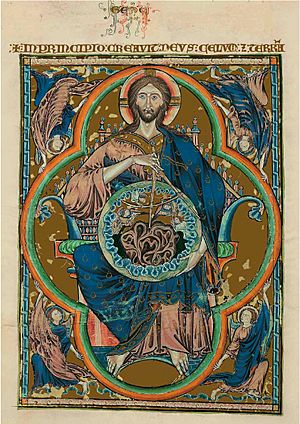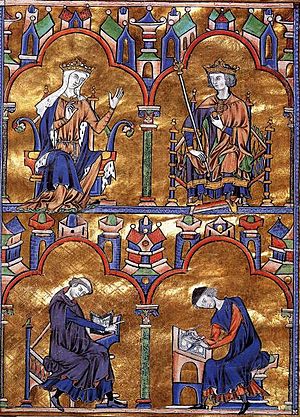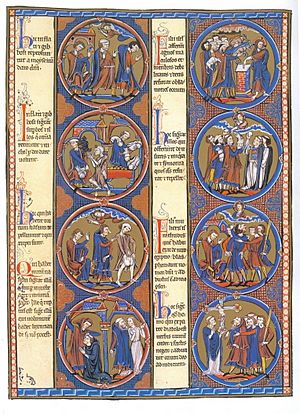Bible of St Louis facts for kids
The Bible of St. Louis, also known as the Rich Bible of Toledo, is a very special old book. It's not a full Bible, but a Bible moralisée. This means it contains parts of the Bible text along with many beautiful pictures and explanations.
This amazing book was created between 1226 and 1234 for Louis IX of France, who was a young king. His mother, Blanche of Castile, asked for it to help him learn important lessons. Each page pairs stories from the Old Testament and the New Testament. The pictures explain the moral meaning and connections between these stories. For example, one picture shows a Bible story, and another picture next to it explains its deeper meaning according to the Catholic Church.
Today, most of this three-volume book is kept safe in the Toledo Cathedral in Spain. A small part, just eight pages, is in the Morgan Library & Museum in New York.
Contents
History of the Bible
People believe the Bible of St. Louis was first mentioned in the will of Alfonso X of Castile, also known as Alfonso the Wise, in 1284. His will talked about "an illuminated Bible in three volumes, given to us by king Louis of France."
This "King Louis of France" was most likely Louis IX of France. Alfonso's father, Ferdinand III of Castile, was a cousin of Louis IX. This shows there were strong family ties between the French and Spanish royal families.
It's not clear if the Bible was in Seville or Toledo when Alfonso wrote his will. However, it likely ended up in the Toledo Cathedral after Alfonso's death in 1284. Perhaps his son, Sancho, donated it.
The Bible of St. Louis probably arrived in Spain after 1254. This was a busy time for connections between the Spanish and French royal families.
The Toledo Bible was listed in an inventory of the Toledo Cathedral's treasures in 1539. But it was described even earlier, in 1466, by a traveler named Gabriel Tetzel. Another book, the Osuna Bible, was copied from the Bible of St. Louis around the late 1300s or early 1400s. This copy shows that the small part now in New York was already missing from the Toledo Bible back then.
The missing part, called the Morgan fragment, was owned by François de la Majorie around 1593. His family owned it for many years until it was bought by J.P. Morgan in 1906.
Who Commissioned the Bible?
There isn't a written note in the Bible saying who asked for it to be made. However, there's a special picture that gives us a clue. On the last page of the Morgan fragment, there's a miniature that tells us about the Bible's creation.
This picture is split into two scenes. The top part shows a queen and a young king without a beard. Many believe this is Blanche of Castile and her son, Louis IX. The queen is sitting on a throne, wearing her royal robe. She is talking to the young king, who listens respectfully. This scene suggests that Blanche gave the Bible to her son. If this is true, then Blanche was the one who ordered the book.
The bottom part of the picture shows two smaller figures. The person on the left is a cleric, a church official, shown by his special haircut. The person on the right is a scribe, someone who writes books by hand. He is working on a Bible Moralisée. It looks like the cleric is giving instructions to the scribe and watching over the work.
Based on this picture, experts believe the book was made between 1226 and 1234. Louis IX became king in 1226 and got married in 1234. Since the picture shows a young, unmarried king, the Bible must have been made during those years.
What the Bible Looks Like
The Bible of St. Louis today has three large volumes in the Toledo Cathedral. It also has a small part of 8 pages, called a fragment, in the Morgan Library & Museum in New York.
- Volume 1
This volume is about 42 cm tall and 30 cm wide. It has 192 pages made of parchment, which is a type of animal skin used for writing. The first page has a full picture of God the Son creating the universe. This volume contains 1,529 small pictures. It covers parts of the Old Testament books like Genesis, Exodus, Job, and many more.
- Volume 2
This volume is about the same size as Volume 1. It has 224 parchment pages and 1,792 small pictures. It continues with books like Psalms, Proverbs, Isaiah, and other Old Testament prophets.
- Volume 3
This volume is slightly taller, about 43 cm. It has 190 parchment pages and 1,520 small pictures. This volume is dedicated to the New Testament. It includes texts from the four Gospels, the Acts of the Apostles, and letters from Paul, James, Peter, and John. It also has parts of the Book of Revelation.
- Volume 4 (Morgan M240)
This fragment is smaller, about 37 cm tall. It has 8 parchment pages and 57 small pictures. It contains the last chapters from the Book of Revelation.
The content of the Bible of St. Louis is very similar to the standard Bible used in Paris in the 1200s. However, some books are missing from the Toledo Bible, like the books of Chronicles and Maccabees.
The Pictures and Their Meaning
The Bible of St. Louis has a special layout, just like other early Bibles Moralisées. Each page has two columns, and each column has four small pictures, called medallions. These pictures are arranged in pairs.
The top picture in each pair shows a scene from the Old Testament. The bottom picture shows a related scene from the New Testament. Or, it might show a deeper, symbolic meaning of the Old Testament story. Next to these pictures, there are two narrow columns with short explanations.
The artists only painted on one side of each parchment page. This made the book much larger and very expensive to create. They used the rougher side of the parchment so the paint would stick better.
The pictures are painted on a shiny gold background. The artists used many bright colors like blues, greens, reds, and yellows. The artwork is very detailed and expressive. Most medallions show one scene, but some are split in two. The artists sometimes used the moral lessons to show their views on society at the time. The Bible gives us a glimpse into medieval life in the 1200s, showing people, social groups, good and bad behaviors, clothes, customs, and games.
Other Similar Bibles
The Bible of St. Louis is one of four early Bibles Moralisées made between 1220 and 1234. These books are very similar, especially the Oxford-Paris-London version and the Toledo-Morgan version.
The oldest Bibles Moralisées are in Vienna. They are similar to each other, but one is shorter and in Old French, while the other is in Latin. Experts now believe they were made in Paris.
The Bible of St. Louis and the Oxford-Paris-London Bible are considered the "second generation" of these books. They follow the standard Bible text more closely. Many scholars think the Bible of St. Louis might have been a model for the Oxford-Paris-London Bible. The pictures in the Toledo Bible are generally better quality, suggesting it was made with more time and care.
The Oxford-Paris-London Bible was also copied later, around the late 1200s or early 1300s. The Osuna Bible in Madrid is a copy of the text from the Bible of St. Louis. In this copy, spaces were left for pictures, but they were never painted.
List of Bibles Moralisées
- Vienna, Österreichische Nationalbibliothek, Codex Vindobonensis 1179 (1220-1226)
- Vienna, Österreichische Nationalbibliothek, Codex Vindobonensis 2554 (1220-1230)
- Oxford-Paris-London (around 1233)
- Oxford, Bodleian Library, Ms. Bodley 270b
- Paris, BnF, Ms. Latin 11560
- London, British Library, Harley Ms. 1526-1527
- Toledo-Morgan (around 1233)
- Toledo, Cathedral of Toledo, Bible moralisée (Biblia de San Luis), 3 volumes
- New York, Morgan Library and Museum, M. 240 (fragment)
- London, British Library, Add. 18719 (Copied from the Oxford-Paris-Harley late 13th to early 14th century)
- Paris, BnF, Fr. 167 (1345-1355) – The Bible of John the Good
- Paris, BnF, Fr. 166 (mid 15th century) – The Bible of Philip the Bold
- Madrid, Biblioteca Nacional de España, Ms. 10232 (14th century)
See also
 In Spanish: Biblia de San Luis para niños
In Spanish: Biblia de San Luis para niños




